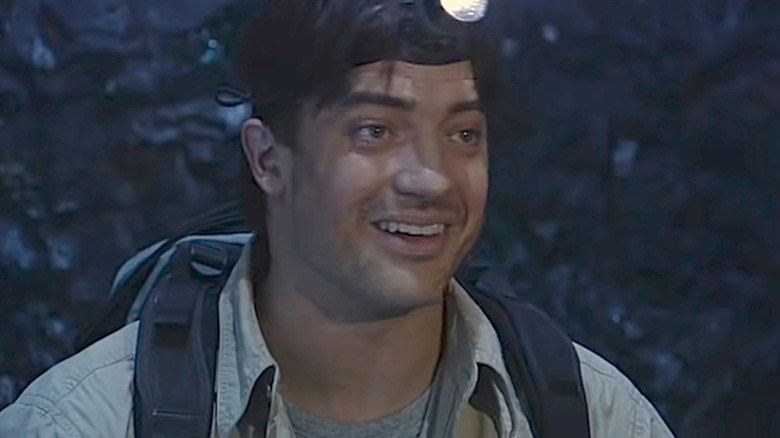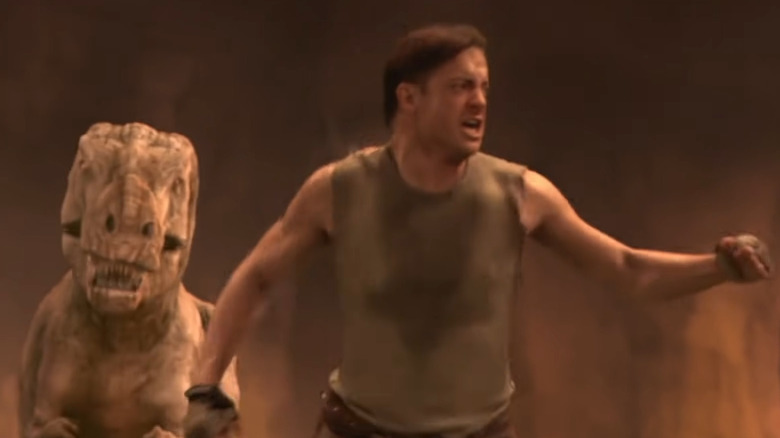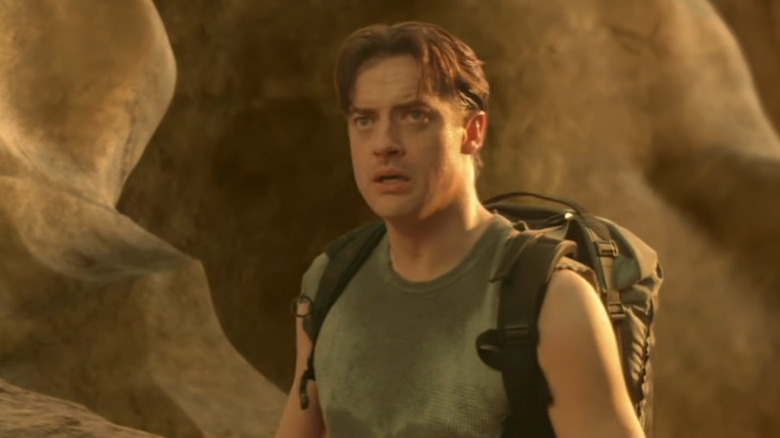How Brendan Fraser's Journey To The Center Of The Earth Made Movie History
It's so great to see Brendan Fraser at the top of his game again. After films like 1992's "Encino Man" and 1997's "George of the Jungle" launched his career, he became highly sought-after in the 1990s and 2000s. Fraser's critically-acclaimed role in "Gods and Monsters" showed his range, and films like "Blast From the Past," "Bedazzled," and the massively successful "The Mummy" franchise proved his leading-man star power even more. Box office hit "Journey to the Center of the Earth" grossed $244 million worldwide. But he slowly seemed to vanish after "The Mummy: Tomb of the Dragon Emperor," and Hollywood no longer seemed to cast Fraser anymore. So it was quite vindicating to see him take home the best actor Oscar on March 12, 2023, for his performance in "The Whale."
Fraser has not only set box office numbers on fire, and won a long-awaited Oscar, but he also made movie history with "Journey to the Center of the Earth." While promoting the film, Fraser described it to Vegas Film Critic as "a cool movie the likes of which an audience has not seen before in history," because it used cutting-edge technology to create an immersive experience. "This is the first live-action, feature-length, narrative-driven, high-definition, preconceived, and delivered 3D film ever made," he said.
Given the long history of 3D movies — the original technology dates to at least the 1800s — it seems unlikely that this 2008 movie would set such a precedent. It mostly achieves that if you add together all the qualifiers Fraser mentioned. Let's investigate.
The film took a technology lesson from James Cameron
While the bloom is off the 3D rose nowadays, the technology in "Journey to the Center of the Earth" was relatively new in 2008, and not like the days of the nausea-inducing red-and-green glasses utilized in the 1950s.
"The technology's come to a place now where we don't have that problem anymore. The glasses, well, they may look a little bit Buddy Holly — hey, it's hip to be square — but they work," Brendan Fraser told Vegas Film Critic. "And the audience is in effect the star of the movie because the movie is about the experience itself."
But wait, surely visual effects pioneer James Cameron must have accomplished this before, you say. Yes and no. After 3D's revived popularity in the early 1980s earned its not-so-stellar reputation of cheesy special effects and low-brow sequels ("Jaws 3D," anyone?), Cameron's "Ghosts of the Abyss," a brilliant 2003 documentary exploring the wreck of the Titanic, brought audiences back to theatres for 3D. It was filmed with high-definition digital cameras, allowing digital filming from the get-go, and led to the technology Cameron used for "Avatar" in 2009. Cameron's "Abyss" visual-effects photographer Eric Brevig directed "Journey to the Center of the Earth," and filmed it with Cameron's digital 3D cameras, making it the first live-action narrative feature film shot in 3D.
What's more, Fraser became a real-life hero to the visual effects artists working on the film, the ones who made it the history-making movie it is.
Fraser became a real-life hero to the visual effects artists on Journey
As technology often does, the advancements in "Journey to the Center of the Earth" made some movie-making aspects faster and easier. "Visitors to the set could watch the footage in 3-D as I was filming," director Eric Brevig told Entertainment Weekly. "This is definitely moviemaking of the future." But this also made it easier for producers to take advantage of the visual effects artists who actually do the work. This became apparent in that film, and Brendan Fraser stepped in to save the day.
After Fraser won best actor at the 2023 Oscars, VFX supervisor Dave Rand tweeted about his experience on "Journey to the Center of the Earth," when Montreal-based VFX company Meteor Studios stopped paying its artists and filed for bankruptcy but convinced them to finish the film. Rand's team was "guaranteed" payment plus overtime, some $1.3 million. But instead of getting paid, Rand alleged that his team was shown the door and that they ultimately learned they weren't going to get their money.
Rand went to the press, but no one wanted to cover it. "My guess was the studio had put pressure on them to bury it," he wrote. After Page Six covered it briefly, Rand received an unexpected phone call from Fraser directly, asking what was going on. '[Brendan] publically campaigned for us," Rand continued. "We finally got 80% of our money almost 2 yrs later." Rand continues to speak out not only in praise of Fraser; he is also demanding a change in the film industry, which he believes is broken in a number of ways.


